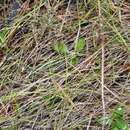More info for the terms:
forest,
hardwood,
headfire,
litter,
shrubs,
tree,
wildfireThe longleaf pine-bluestem savanna of the southeastern United States
Coastal Plain, where slender bluegrass is a dominant, is a fire
subclimax community which requires fire at relatively frequent intervals
to be maintained. When fire is excluded, loblolly pine (Pinus taeda),
slash pine, hardwood trees, and shrubs invade; slender bluestem is
shaded out [
24].
In the absence of fire in dense stands of longleaf pine on the
southeastern Coastal Plain, slender bluestem is eliminated by pine
needle litter [
20,
36].
Burning increases slender bluestem nutrient content and palatability.
Increases do not last more than a few months after spring burning.
However, this is usually the time when livestock and wildlife need extra
protein and minerals [
24].
Rotational winter burning at 3-year intervals in longleaf pine/bluestem
range, combined with periodic tree thinning (to maintain 12 to 20 sq
m/ha longleaf pine basal area), can maintain productive forage
(including slender bluestem) and provide concurrent production of wood
fiber [
37].
Three major studies on the effect of fire on slender bluestem forage
have been done in south-central Louisiana:
A 6-year test of rotation burning to increase forage value during summer
and fall and to improve distribution of grazing by cattle was conducted
in south-central Louisiana. Slender bluestem and pinehill bluestem were
the principal grasses. A system of rotational burning was recommended
for longleaf pine/bluestem range for both cutover and timbered lands.
One-third of each area was burned in winter or early spring each year.
Low-intensity early March backfires were used in subunits with
regenerated pines to minimize damage to trees. Free-running early May
headfires were used on cutover land to destroy herbage after
palatability of normal spring growth started to decline. Wildfire
hazard in the forest was reduced, range vegetation and grazing
distribution were improved, litter was removed, undesired scrub
hardwoods were top-killed, and unpalatable perennials were curtailed.
Both types of sites were grazed by cattle. The heavy grazing of slender
bluestem during the growing season following fire, when cattle
concentrated on freshly burned range, improved forage palatability and
nutritive content by retarding maturation. Cattle began concentrating
on newly burned range within 1 to 4 weeks of burning [
9]. The ensuing 2
years of lighter use restored slender bluestem vigor [
9,
19]. Dry cows
and cows with calves gained weight throughout the growing season on
rotation-burned ranges; forage values on unburned ranges during summer
and fall were too low to sustain body weight [
9,
23].
In south-central Louisiana longleaf pine-bluestem range was subjected to
alternate burning rotations from 1967 to 1970. Dominant grasses were
slender bluestem and pinehill bluestem. One range was treated with a
single fire in late winter or early spring each year. The other range
was burned a third at a time during each year, one fire in winter (March
1), one in spring (May 1), and one in summer (July 1). Cattle grazed
the burned area of the annual winter-only fire almost continuously,
which maintained a supply of new palatable and nutritious growth as well
as if later burning had been done. A single winter fire, being simpler
and less expensive than spring and summer fires, is recommended for
forage management on forested or clearcut native range in longleaf
pine-bluegrass range [
18].
Longleaf pine-bluestem range in south-central Louisiana was subjected to
burning or mowing and raking treatments. Dominant groundcover was
slender bluestem and pinehill bluestem. In 1962, four plots were burned
by headfire; four others were mowed to near ground level and residue was
raked and removed. The treatments were reapplied in 1963. Fire did not
stimulate early growth or increase nutrient content of slender bluestem
more than did mowing and raking. Removal of litter by either treatment
appeared to be the major cause of improvement in the status of slender
bluestem [
17].

